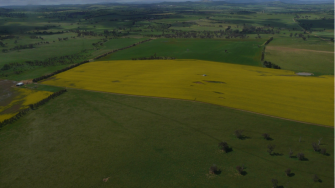
Date: Saturday, October 22, 2016
Project: Eastern Australian Waterbird Survey
Observer: Terry Korn
After an overnight stay in the Walter Burley Griffin designed Riverina town of Griffith, we woke to five degrees outside and strong wind chill with very cold south-westerly winds. Waterbirds are similar to people in that they avoid exposure to cold winds, if they can. So most birds we encountered during this short day were on or near protected shorelines seeking respite.
Griffith is similar to Canberra in design. Photo Terry Korn
The highlight of the morning was counting the Ramsar listed Fivebough and Tuckerbill swamps just out of Leeton. These small natural wetlands have been nurtured by the local community, have good visitor facilities for keen bird watchers and provide visual relief from square irrigation bays which dominate the area. However, results here were consistent with our experience elsewhere – very low numbers and few species. Grey teal dominated with black-winged stilts, black swans and egrets a long way back. During dry times this system is entitled to environmental water, becomes a focal point for waterbirds and supports very high numbers of many species.
These two bodies of water connect via the tree covered depression along centre top of the photograph to form the Coolah Lake/ Meejum Swamp complex. Narrandera is about 10km south. Photo Terry Korn
East of Fivebough Swamp and directly north of Narrandera is the large ephemeral Coolah Lake/Meejum Swamp complex which only fills when the Murrumbidgee floods. The last time this area was inundated was in 2010 but this time there is more water. Most of it is outside the band we count. Again only a few birds were counted on this very large waterbody. It is always interesting to see how the river and floodplains interact during a flood.
From this point it is a flight through the mixed farming western slopes of the Great Dividing Range. Crops, sheep, cattle and feedlots prevailed in the dazzling green of a wonderful season as we headed towards Crookwell to count some large farm storages.
The dazzling green and yellow of mixed farming country near Stockinbingal. Photo Terry Korn
However the weather was against us. Two minutes before arriving at our first site near Crookwell, we found low clouds scraping the hill tops so we abandoned the count. Thereafter followed a 30 minute instrument flight in thick cloud before landing at Bankstown airport with some relief. It is unsettling for us non-pilots when we have no option but to place all trust in technology.
